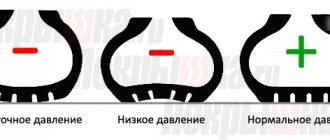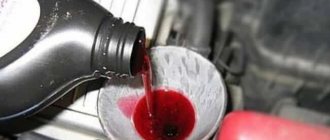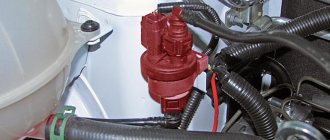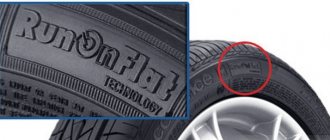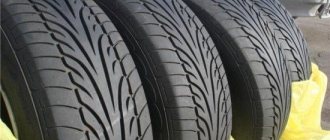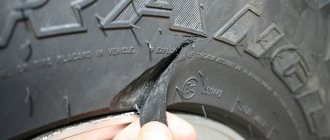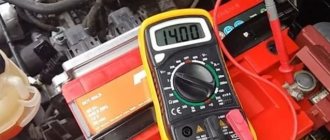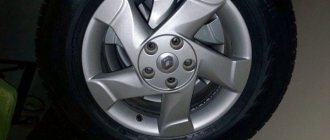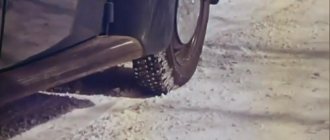Step-by-step instructions: how to inflate a tire yourself with a compressor
When choosing a product, first of all pay attention to the wire, which in relatively inexpensive models is powered from the cigarette lighter. As for higher class products, they are powered by a battery.
Once you know where to insert the connector, connect the wire to ensure smooth operation of the compressor.
Inflating tires with a compressor
Then tightly connect the compressor hose and the car wheel nipple by screwing. In some models, this will require considerable physical effort. At the same time, information about the current state of tire pressure will appear on the pressure gauge. This information is needed to indicate pressure limits.
At the most critical stage, switch the compressor switch to operating mode. If you did everything correctly, the car tires will begin to swing automatically. Do not ignore this process, because it is absolutely undesirable to overdo it and inflate the wheel beyond the required volume. A pressure gauge will help you check the number of atmospheres. He defines them very precisely.
Measuring pressure immediately after stopping
Often, motorists do not pay attention to when exactly it is necessary to check the degree of tire inflation. They do this every chance they get. Since this indicator depends on various factors, this should be done correctly. Otherwise, the indicators will have significant errors.
To obtain accurate data, it is recommended to check the pressure only on a cooled machine that has been standing for at least five hours. Only checking “cold” tires with a pressure gauge can show the correct result.
How to solve the problem of a flat tire at a gas station
At modern gas stations, in addition to the service of filling the tank with fuel, it is possible to solve the problem of a flat tire. Today you need to know how to pump up a car tire at a gas station.
You can pump up your tires at any gas station
The rules and procedure for inflating tires at a gas station are practically no different from the conditions of a garage or car service center. Be sure to turn off the engine and carefully follow the procedure already described.
The compressor at the gas station is improved, and therefore, as an addition, it has a built-in pressure gauge and other settings. This is explained by the fact that gas stations are considered specialized places for this procedure.
Tire inflation station at a gas station
Start inflating tires by setting the appropriate pressure and put the device into operation. Built-in automation will do everything independently in compliance with all safety measures.
- Inflate the wheels clockwise, so start the process by unscrewing the cap from each wheel in turn. Place it somewhere near the car so you don't lose it.
- The next step is to properly place the nozzle on the nipple. Please note that in this situation everything must be done smoothly and air bleeding must be minimized. Set the pressure in the tires of the car that suits you.
- The correct operation of the compressor will be indicated by flashing yellow or red lights. After the sound signal, the green lamp will light up, and the procedure is considered completed.
Procedure for inflating wheels
By the time all doubts that the tire is weak have disappeared, the driver should already know how to inflate a car tire
And begin to restore the pressure necessary for the stable service of this important component of motor transport. The order here is:
- you need to remove the cap from the valve located on the tire:
- Place the hose from the pump onto the valve;
- check the pressure gauge readings. If below normal, pumping is necessary. It is not recommended to pump up the wheels for future use. Otherwise, you can overinflate the chamber and it will simply burst. Or the wheels will become too hard and hard, which is also bad.
- in the case when, during pumping, more air was forced in than normal, there is only one way out: remove the hose and bleed off the excess air by pressing the nipple.
And finally, some life advice. Since we had to use a pump and a pressure gauge to inflate one wheel, it makes sense to check the rest as well. The pressure gauge measures the pressure on each wheel. And the pump, if necessary, pumps up.
Drivers know that it will not be possible to inflate a tubeless tire with a conventional pump after installing it on the rim - the air will simply come out of the gap between the rim and the tire rim. In order for the tire to “sit” tightly in its place on the rim, you need to supply a large portion of air in a short time, for example from a compressor receiver, as is done at a service station. But not everyone has such compressors in their garage, so how can you get out of the situation and pump up the “tubeless”, using what is called “improvised means”?
It's actually not that difficult to do.
To do this you will need some gasoline, carburetor cleaner, WD-40, or any other flammable liquid. Place the fully assembled wheel on the ground and spray a very small amount of flammable liquid in a circle into the gap between the tire and the rim. Do not pour too much gasoline, about 10 grams is enough. After this, quickly ignite the resulting flammable liquid vapors in the tire (just throw a lit match into the area of the gap between the tire and the rim).
There will be a popping sound and the tire will snap into place tightly. Now the tire can be inflated with a conventional pump to the required pressure.
If this method seems too extreme to you (after all, you need to be careful with fire and gasoline so as not to burn the entire car), you can use another method. Inflate any car wheel or spare tire to a pressure of about 4 atm. Remove the hose from the pump and connect its free end (the one without the fitting) to the nipple of the tubeless tire that needs to be inflated (the spool from the nipple must be removed). Now connect the other end of the hose, on which the fitting is located, to the “inflated” wheel. As a result, the air from the inflated wheel will very quickly be distributed into the tubeless tire, and it will fall into place on the rim. Now you can remove the hose, screw the spool valve into the tubeless nipple, and pump it up in the usual way to the required pressure.
The following materials:
Previous materials:
Any motorist will confirm that it is very problematic to inflate an empty tubeless tire on your own, unless you have a high-pressure compressor in the garage, which is used in tire shops and service stations. In order for the tire to fit tightly to the rim of the disk without a gap, you need to supply a large amount of air into it in a short period of time, which is impossible to do with a conventional pump. What to do in a situation where there is no service station nearby and the tire is empty?
There are several ways to inflate a tubeless tire using available tools. The main task is to install the tire at the mounting location. When it closes tightly, it can be inflated using a conventional pump.
Working and non-working methods in the absence of a compressor
Remember that you can inflate the tires on your vehicle without a pump. Let's figure out how workable these options are.
Turbocharging
For example, you can use turbocharging, the essence of which is to attach a hose to the air path after the turbocharger. They say online that it will work in case of an emergency, but in fact the boost pressure between the compressor and the engine intake valves is completely insufficient to inflate the tire.
In skillful hands, turbocharging can be used to pump up wheels
Aerosol can
You can also use an aerosol can. Craftsmen who deal with iron gadgets usually have similar ones. Such devices are used to clean systems and boards from dust. The procedure looks similar: you need to attach a can of liquid to the nipple and press on it. You can inflate a tire this way, but you will need a lot of cans. Impractical and expensive.
An aerosol can can be used to inflate tires
Fire extinguisher
If you have a fire extinguisher, you can also use it. The pressure in the wheel rises by a couple of bars, but from the inside... It’s better not to look at what will happen there and what it will turn into after a while.
In fact, none of the above methods will provide the desired result, but, on the contrary, will bring many problems.
Fire extinguisher as a means of inflating tires
What to download?
You can inflate the wheel using:
- Pitching (hand/foot).
- Compressor.
- Special equipment that is present at the gas station.
<<Tire compressors>>
The optimal (recommended) pressure for a particular vehicle is indicated on the plate in the doorway on the driver's side and in the vehicle's operating instructions.
How to use a car compressor
A car compressor for inflating wheels is an electric motor with a piston and cylinder. To supply power to the electric pump motor, a long wire with a plug is used. The plug design is designed for quick connection to the cigarette lighter socket. Simply plug into the cigarette lighter and then press the switch on the compressor. Everything should work.
What to do if the cigarette lighter does not work? A new problem appears due to a blown fuse. You can open the fuse box and check the elements for thread integrity. If this turns out to be the reason, then it can be easily eliminated by installing a new fuse.
The cigarette lighter continues to refuse to work, and there is no time to search for the causes of the problem. You will have to connect the compressor to the battery directly. To do this, cut off the plug from the cable. Next, strip the ends of the wires so that the wire can be made into a loop around your finger. These will be the terminals. We put improvised terminals on the battery (red wire “+”, black “-”). Turn on the compressor. If the battery is old, it is recommended to pump the wheels with the engine running. In the future, after repairing the cigarette lighter, the cut plug must be connected to the cable, and the twisted wires must be insulated.
Wheel inflation rules
If you have a compressor, but no experience in inflating wheels, then you should conduct exercises. To do this, it is enough to know the rules that will help you act in a certain sequence:
- take the compressor and free it from the protective cover;
- install next to the flat tire;
- unscrew the nipple cap and place the hose tip on the fitting;
- take the plug and connect it to the cigarette lighter;
- we return to the wheel and turn on the toggle switch on the compressor;
- after pumping up the required pressure, turn off the toggle switch;
- remove the compressor in reverse order.
The pump hose tip has a lock. In the vertical position, the valve is closed and the tip is ready to be attached to the wheel fitting. After moving the lever to a horizontal position, the tip is fixed on the fitting, opening the nipple for air supply.
What pressure to pump - where to find out
Each car is designed to use a specific tire size. In addition, the tires must have operating pressure. To inform the car owner about the type of tires and the air level, the automaker sticks an information plate in the driver's doorway. Sometimes, the sticker is placed in the passenger doorway. The content is presented in the form of a table, which will indicate different tire pressures for winter and summer operation.
Where and how to order the service?
If the car owner does not have a device for foot or manual tire inflation, then you should contact a tire service station. There are many such organizations today. It is important to choose qualified and experienced professionals.
Overinflating wheels can result in the following:
- Reducing the smoothness of the car.
- Deterioration of adhesion to the road surface.
- Increasing the level of background noise from the highway.
- Increased load on the chassis.
- Quickly erase the cover protector.
Under-inflation of tires leads to the following consequences:
- An accident due to poor road grip and poor vehicle control.
- Increased fuel consumption.
- Quickly erase tires.
When to pump up your tires
You should not wait for the air to completely leak out of the wheels. It is recommended to check the adequacy of tire pressure once every two weeks. This will reduce tire wear, since even minus 0.5 atm reduces the service life of tires, especially the side profile. In addition, weak tires lead to increased fuel consumption, as they are less resistant to rolling resistance. At the same time, underinflated tires are susceptible to the formation of hernias. Moreover, a weak wheel harms the suspension, not to mention the deterioration of the car’s directional stability on the highway.
Train yourself to monitor the condition of your tires. A simple operation of inspecting the wheels and measuring the pressure with a pressure gauge can delay the purchase of new wheels for a couple of seasons. And this is a significant saving on your personal budget.
To inflate a car wheel with a compressor from a cigarette lighter, you need to understand the specifics of operation, types and design of such devices. With their help, you can restore tire pressure or pump up the spare tire. This knowledge will be useful if there are no tire services or gas stations nearby.
A few words about the “specialists” in tires
Many drivers have received “complaints” about professionals working in tire shops. For example, a car owner knows for sure (he looked it up in a cheat sheet) that the normal pressure for his car and the wheels installed on it is 2.2 atmospheres. But his request to pump just that much after “re-shoeing”, balancing, repairing a puncture, and so on, sometimes causes bewilderment among the “specialists”. Like, what are you doing? Where are so many? It will be oak! “You need a deuce.”
In such situations, feel free to insist on your own . Not all tire service centers employ specialists who know and love their job. They just work, hang around for the sake of money. They don’t care about your wheels and their service life, as well as your comfort and safety. Of course, not all of them are like that. But they exist.
Types of auto compressors and their differences
The following types of auto compressors exist:
- Membrane.
- Piston.
The first ones pump air through a rubber sheet, which performs reciprocating movements. Such compressors are also called vibration compressors. The advantages include the absence of rubbing components, and the only element that is subject to wear is a piece of rubber, but it is easy to replace.
Diaphragm compressors have the following disadvantages:
- Relatively low productivity.
- There are a number of difficulties in operation at low temperatures, since the membrane freezes under the influence of negative temperatures.
Piston systems operate on the same principle as simple hand pumps: air is forced through a piston that moves in a reciprocating motion.
The key advantage of this equipment is high efficiency and extended service life.
The disadvantages include strong heating due to intense friction against the cylinder walls and the lack of a filtration system.
There are rotary piston devices that supply large volumes of air, but cheap models are not capable of creating high pressure.
The best models of automobile compressors
To make a list of the best compressors for your car, you need to evaluate their performance and characteristics. The most popular models include the following:
How to convert a compressor from a cigarette lighter to crocodiles
To convert a compressor powered by a cigarette lighter to a battery-powered compressor, you need to buy a special adapter. Often it is supplied complete with the device.
Recently, a compressor for inflating tires has become more than popular among motorists. It replaced the pump not so long ago. The main advantage of compressors is that inflating tires takes little time and does not require any force. But it is advisable to first find out how to use the compressor correctly in order to get maximum output and not reduce its working life.
Compressors come in piston and membrane types. They have different operating principles, but they perform the same task.
Membrane ones are cheaper, but generally they are not recommended for Russian conditions, since the membrane is made of rubber, and in winter and low temperatures it cracks, allowing air to pass through. Ultimately, such an electric pump can only be thrown away. The service life of piston analogues is much longer.
Underinflation when putting on the disc
Even professional tire shop workers make a common mistake during installation. They do not inflate the tire well, so the tire sits very poorly in its place. To avoid such problems, it is recommended to pump it up well.
Here it is enough to focus on the value of 3-3.5 atmospheres. If this is not done, then the installation process on the seat will occur while the car is moving with all the ensuing consequences.
To make the work easier, it is advisable to use tire foam.
Instructions for use
In fact, using a car compressor is not at all difficult; all you need to do is know the whole process and remember the recommendations.
Tire inflation process
The compressor has a power cord. If it is a cheap model, it will have a cigarette lighter socket. On more expensive devices, this wire is bifurcated, with terminals for connecting to the battery. Thanks to this, the power increases. Of course, if we are talking about a high-quality battery. You can choose one at https://www.rimir.by, where a wide range of batteries is presented.
- First you need to connect the wire so that the electric pump has something to power from.
- Then you need to tightly screw the compressor hose to the wheel nipple. At this stage, you can see the tire pressure on the tire pressure gauge and understand how much it needs to be increased.
- Now the last stage. It is necessary to switch the device switch to operating mode. The tire inflation will begin. The main thing here is not to overdo it and inflate the wheel to the required volume - it can be tracked on the pressure gauge.
Also, do not forget about a very important operating rule. It is necessary to inflate the wheels or simply check the tire pressure in a place where the conditions are the same as when operating the car. Also, the tires should not be cold after the trip.
In order for the tires to become normal temperature, after use you need to wait about half an hour, depending on the weather. If you do not follow this rule, the pressure will be incorrect, and besides, it may differ in each wheel. If the wheels were inflated in the cold, then when the temperature changes to positive, the pressure will rise, and this can lead to dire consequences.
Methods for pumpless pumping of chambers
About the design and operation of a car. What is the difference between 92 gasoline and 95. Compression ratio and a modern car. From a technical point of view
Is it possible to inflate bicycle inner tubes without a pump? It is unlikely to reach the recommended pressure, since a regular supply of air under pressure is required, but it is possible to reach the minimum values. Let's look at several methods of pumping chambers that can be used without using a pump:
Vacuum cleaner.
Many models are equipped with a blower mode, when switched to which the air is blown out. A thin hose can be used to connect the wheel nipple. The result directly depends on the tightness of the connection between the hose and the nipple. Here you can use rubber pads, clamps and even rags.
Bottle pump.
You will need two plastic bottles. One of them will serve as a cylinder, the other as a rod. Cut off the bottom of the first bottle and connect its neck through a thin hose to the chamber outlet. Next, insert the second bottle into it and pump air through the cylinder into the hose with progressive movements. To ensure a tight seal, coat the connection between the neck and the hose with sealant or install a rubber pad. It will not be possible to create high pressure, but you can ride a bicycle for N distance.
Schematic representation of a bottle pump: 1 – “rod”, 2 – cylinder, 3 – cylinder neck, 4 – hose
The third way is to remove the nipple and inflate it like a balloon. The method involves difficulties in removing it and installing it in its rightful place. It will be especially difficult to install it back, since during this time all the air can be released.
An alternative to tire inflation is using a bicycle air fork pump. You will have to work hard, since this pump is designed for small volumes.
Despite the fact that a resourceful person will find a way out of any situation, it is recommended to have a special pump for inflating tires. Moderately inflated bicycle tubes are the key to comfortable rides without unpleasant surprises in the form of a burst tube or damage to the wheels.
Meanwhile, cyclists feel a lack or excess of pressure much more acutely. When the wheel is not inflated to the required level, you have to exert more effort when moving - the area of contact of the tire with the surface increases. If the wheel is overinflated, this is also not good, as it can lead to a defect in the tube or its explosion.
Tire pressure is checked with a pressure gauge.
Typically, the pressure that is recommended for your bike or tires is indicated on the two-wheeler's data sheet, or directly on the side of the tire itself (usually indicated in bar, or pounds per square inch - PSI).
Features of operation of different compressors
If you have a membrane compressor, you must adhere to the following recommendations:
- It does not need to be heavily overloaded, otherwise the device may fail due to excessive loads.
- It should not run for more than 15 minutes.
- The most favorable conditions for this type of device are regions with a warm climate.
In the cold they can fail. As mentioned above, this is due to the fact that the rubber membrane at low temperatures begins to harden and then crack. The protective layer of the wires also suffers, causing the wires themselves to short out. This will eventually cause the fuse in the cigarette lighter to blow.
Piston-type compressors do not have such problems. They work without problems in any conditions, both cold and hot. However, it is also impossible to operate them without breaks, since the piston causes a large load.
In fact, the design of compressors is simple, so anyone can understand how it works and learn how to use it correctly. You just need to learn about the main points and listen to the recommendations, then the device will last a long time and will not cause problems.
Cars travel on pneumatic tires, which can be damaged at any time during operation. Complete depressurization or partial bleeding of air occurs for several reasons, for example, a screw is stuck in the tread, a brass valve has oxidized, or the edge of the rim has become deformed after hitting a pothole. Experienced drivers have an idea of how to act in such a situation. But it will be useful for novice drivers to learn how to inflate a car wheel with a compressor and how many atmospheres should be in the cylinder.
Uneven tire pressure
Ideally equal pressure in all four wheels is a fairly rare phenomenon. However, if the spread is no more than 0.1 bar, then this does not cause any trouble. There are completely “different rates” when, for example, one wheel has 2.1 atmospheres, and a coaxial one has 1.8 or even less.
The problems awaiting the car owner in this situation are approximately the following:
- The car pulls to the side . This happens for two reasons. The first of them lies in reducing the diameter of the wheel. The second is the difference in friction forces between the rubber and the road surface. One wheel (pumped) seems to roll faster and easier than the second on the same axle (lowered). You can feel this on a flat road even at very low speeds - the car itself “goes” to the side, although it should drive strictly straight, even if you completely release the steering wheel. A similar picture is also observed on cars whose wheel alignment is incorrectly adjusted or whose rims are crooked (not round) and unbalanced.
- Rubber wears unevenly . The reason in this case is quite simple - different loads on coaxial tires. Why this happens is described in the previous paragraph.
- The risk of going into an uncontrolled skid increases . Moreover, both during acceleration and during braking (emergency). The reason is still the same - uneven distribution of load between the wheels. For example, when braking with the wheels locked, one of the two wheels on the axle glides along the road surface more easily, while the other slides worse. As a result, the car begins to pull to the side and, if you do not release the brake pedal or do not have the proper experience, an uncontrolled skid occurs, controlled only by inertia and centrifugal force.
- Friends constantly pester me: “Your tire is flat, pump it up . Although this point looks more like a joke, such remarks when they reach a certain frequency begin to get pretty unnerving.
There are no advantages to unequally inflated tires (as opposed to equally inflated or half-flat tires), and there cannot be any. This is only danger, discomfort and increased costs.
How to use a car compressor
A compressor for pumping air into a car tire consists of an electric motor with a piston group. The motor is powered by a 12 V voltage supplied through a long wire with a plug. The latter is designed to operate from a cigarette lighter. After connecting, just press the compressor toggle switch and it will pump.
What to do if the cigarette lighter does not function? It can take a long time to look for the cause, but you need to go now. In this case, you need to connect the compressor directly to the battery. You have to cut off the plug and trim the ends of the main cable by 6-8 cm.
We make a loop around the finger, simulating a terminal. We put the wires on the battery (red “+”, black “-”). We tighten the twists for better contact. Turn on the compressor toggle switch and pump up the tire. Then we disconnect the wires from the battery, twist them back with the plug and wrap them with electrical tape.
Wheel inflation rules
“It’s hard to learn, it’s easy to fight.” If you have never used a compressor before, you should do a practical lesson. The algorithm of actions will become clear, and in the case of hour “X” you will easily cope with the task. The sequence of actions is as follows:
- Wear gloves.
- Open the trunk, take out the compressor and free it from the cover.
- Place it near the flat tire.
- Unscrew the cap from the valve (nipple) and install the hose fitting on it.
- Fix the flag on the fitting at an angle of 90°.
- Plug the plug into the cigarette lighter socket.
- Turn on the compressor and wait for the required mark on the pressure gauge.
- Then turn off the compressor and disconnect it from the power supply.
- Assemble the device into a protective case and put it in the trunk.
- Screw the cap onto the wheel valve.
If it’s rainy outside, it’s better to hide the pump under the car. This will help avoid possible short circuits and corrosion.
When to pump up your tires
Tire pressure is one of the important parameters for a car, despite its apparent simplicity. An air leak of 0.2 atm accelerates tire wear by 30% and increases fuel consumption. In addition, driving may become difficult. Directional stability deteriorates and a tendency to lateral drift appears.
The car becomes more dangerous for other road users. Experts recommend checking your tires and, if necessary, inflating them in the summer at least once a month. In winter, diagnostics should be carried out once every 2 weeks.
